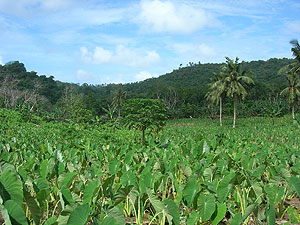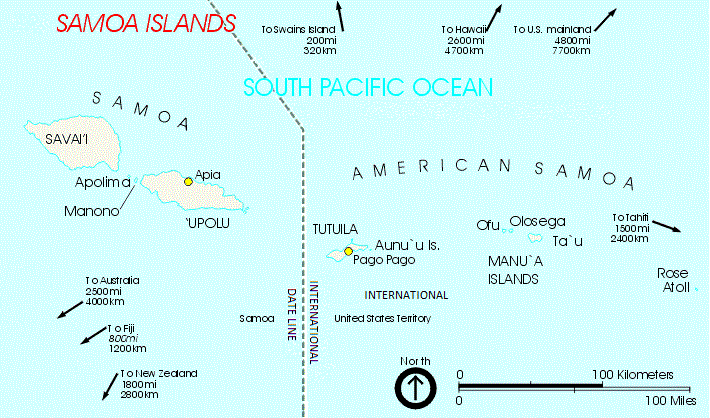|
Turtle And Shark
Turtle and Shark (Laumei ma Malie in Samoan language, Samoan) is a place with association to an important legend in the culture of Samoa. It is located on the southern shore of Tutuila, the largest island of American Samoa, a short way south of the village of Vaitogi, American Samoa, Vaitogi. The feature known as Turtle and Shark is a U-shaped cove, set between Vaitogi Beach to the north and a basalt cliff to the south. The cove is about measured from east to west and measured from north to south. The topography of the cove is such that it is frequently subjected to high-energy wave action, with spray thrown high into the air. The cove is believed by the Samoan populace to be the location of the climactic scene of the Turtle and Shark legend, one of the island's best-known and popular tales. The earliest documented form of the Turtle and Shark legend was published in 1884 by a missionary: A story is told of a woman and her child, who in a time of great scarcity were neglecte ... [...More Info...] [...Related Items...] OR: [Wikipedia] [Google] [Baidu] |
Vaitogi, American Samoa
Vaitogi is a village in American Samoa. It has many missionaries and tourists who are attracted by shopping for local products. Vaitogi might be most famous of its legends about the Turtle and Shark (Laumei ma Malie). It is said that once, at a time when food was scarce, an old woman took her granddaughter to the bluff at Vaitogi, and holding hands, they leaped into the sea down below. While the young girl was transformed into a shark, the blind grandmother became a turtle. It gives its name to a local U-shaped cove in town, which was listed on the U.S. National Register of Historic Places in 2014. Fogāma'a Crater Trail is a 3-mile roundtrip hiking trail in Vaitogi. The trail goes by two scenic beaches before ending at the junction with the Fagatele Bay National Marine Sanctuary Trail. Fogāma'a Crater is a National Natural Landmark. It is home to Tessarea Vaitogi Inn, which is a hotel in town. Etymology Although there is no specific account of the name’s origin, the name m ... [...More Info...] [...Related Items...] OR: [Wikipedia] [Google] [Baidu] |
Samoan Language
Samoan ( or ; ) is a Polynesian language spoken by Samoans of the Samoan Islands. Administratively, the islands are split between the sovereign country of Samoa and the United States territory of American Samoa. It is an official language, alongside English, in both jurisdictions. It is widely spoken across the Pacific region, heavily so in New Zealand and also in Australia and the United States. Among the Polynesian languages, Samoan is the most widely spoken by number of native speakers. Samoan is spoken by approximately 260,000 people in the archipelago and with many Samoans living in diaspora in a number of countries, the total number of speakers worldwide was estimated at 510,000 in 2015. It is the third-most widely spoken language in New Zealand, where 2.2% of the population, 101,900 people, were able to speak it as of 2018. The language is notable for the phonological differences between formal and informal speech as well as a ceremonial form used in Samoan oratory. Cla ... [...More Info...] [...Related Items...] OR: [Wikipedia] [Google] [Baidu] |
Culture Of Samoa
The traditional culture of Samoa is a communal way of life based on Fa'a Samoa, the unique socio-political culture. In Samoan culture, most activities are done together. The traditional living quarters, or '' fale'' (houses), contain no walls and up to 20 people may sleep on the ground in the same fale. During the day, the fale is used for chatting and relaxing. One's family is viewed as an integral part of a person's life. The aiga or extended family lives and works together. Elders in the family are greatly respected and hold the highest status, and this may be seen at a traditional Sunday '' umu'' (normal oven). Samoan culture is present in both the Independent State of Samoa and in American Samoa (a territory of the United States). Traditional art forms Both men and women can be tattooed (''tatau''). A man's tattoo is called the soga'i miki while a woman's tattoo is called a ''malu''. Women play an important part in contributing with their skills in items of important c ... [...More Info...] [...Related Items...] OR: [Wikipedia] [Google] [Baidu] |
Tutuila
Tutuila is the main island of American Samoa (and its largest), and is part of the archipelago of Samoan Islands. It is the third largest island in the Samoan Islands chain of the Central Pacific. It is located roughly northeast of Brisbane, Australia and lies over to the northeast of Fiji. It contains a large, natural harbor, Pago Pago Harbor, where Pago Pago, the capital of American Samoa, is situated. Pago Pago International Airport is also located on Tutuila. The island’s land expanse is about 68% of the total land area of American Samoa. With 56,000 inhabitants, it is also home to 95% of the population of American Samoa. The island has six terrestrial and three marine ecosystems. Tutuila has mountainous regions, the highest point of which is ). The island is attractive to tourists because of its beaches, coral reefs, and World War II relics, as well as its suitability for sporting activities such as scuba diving, snorkeling, and hiking. Etymology It is said that the nam ... [...More Info...] [...Related Items...] OR: [Wikipedia] [Google] [Baidu] |
American Samoa
American Samoa ( sm, Amerika Sāmoa, ; also ' or ') is an unincorporated territory of the United States located in the South Pacific Ocean, southeast of the island country of Samoa. Its location is centered on . It is east of the International Date Line, while Samoa is west of the Line. The total land area is , slightly more than Washington, D.C. American Samoa is the southernmost territory of the United States and one of two U.S. territories south of the Equator, along with the uninhabited Jarvis Island. Tuna products are the main exports, and the main trading partner is the rest of the United States. American Samoa consists of five main islands and two coral atolls. The largest and most populous island is Tutuila, with the Manuʻa Islands, Rose Atoll and Swains Island also included in the territory. All islands except for Swains Island are part of the Samoan Islands, west of the Cook Islands, north of Tonga, and some south of Tokelau. To the west are the islands of the Wall ... [...More Info...] [...Related Items...] OR: [Wikipedia] [Google] [Baidu] |
Margaret Mead
Margaret Mead (December 16, 1901 – November 15, 1978) was an American cultural anthropologist who featured frequently as an author and speaker in the mass media during the 1960s and the 1970s. She earned her bachelor's degree at Barnard College of Columbia University and her M.A. and Ph.D. degrees from Columbia. Mead served as president of the American Association for the Advancement of Science in 1975. Mead was a communicator of anthropology in modern American and Western culture and was often controversial as an academic. Her reports detailing the attitudes towards sex in South Pacific and Southeast Asian traditional cultures influenced the 1960s sexual revolution. She was a proponent of broadening sexual conventions within the context of Western cultural traditions. Birth, early family life, and education Margaret Mead, the first of five children, was born in Philadelphia but raised in nearby Doylestown, Pennsylvania. Her father, Edward Sherwood Mead, was a professor of ... [...More Info...] [...Related Items...] OR: [Wikipedia] [Google] [Baidu] |
National Register Of Historic Places
The National Register of Historic Places (NRHP) is the United States federal government's official list of districts, sites, buildings, structures and objects deemed worthy of preservation for their historical significance or "great artistic value". A property listed in the National Register, or located within a National Register Historic District, may qualify for tax incentives derived from the total value of expenses incurred in preserving the property. The passage of the National Historic Preservation Act (NHPA) in 1966 established the National Register and the process for adding properties to it. Of the more than one and a half million properties on the National Register, 95,000 are listed individually. The remainder are contributing resources within historic districts. For most of its history, the National Register has been administered by the National Park Service (NPS), an agency within the U.S. Department of the Interior. Its goals are to help property owners and inte ... [...More Info...] [...Related Items...] OR: [Wikipedia] [Google] [Baidu] |
National Register Of Historic Places Listings In American Samoa
File:American Samoa Districts.png, 250px, American Samoa districts (clickable) poly 520 1249 517 1248 482 1247 473 1230 456 1230 450 1237 440 1228 432 1218 428 1216 432 1210 431 1202 429 1198 429 1190 434 1182 438 1180 420 1158 393 1137 396 1133 382 1123 362 1091 598 921 645 908 821 907 1024 895 1023 1153 Eastern District poly 1772 1436 2018 1439 2034 1213 2002 1084 1795 946 1470 937 1105 949 1138 1154 Manu'a District poly 336 1467 453 1405 585 1264 516 1247 491 1247 482 1247 476 1240 473 1234 473 1230 468 1230 460 1230 453 1231 453 1237 449 1237 442 1231 434 1225 428 1215 431 1209 431 1197 428 1191 433 1180 436 1180 438 1176 420 1161 393 1139 394 1131 382 1125 360 1090 282 1024 76 1007 14 1249 166 1347 247 1417 Western District desc none This is a list of the buildings, sites, districts, and objects listed on the National Register of Historic Places in American Samoa. There are currently 31 listed sites spread across the three districts of American Samoa. There are no si ... [...More Info...] [...Related Items...] OR: [Wikipedia] [Google] [Baidu] |




.jpg)
